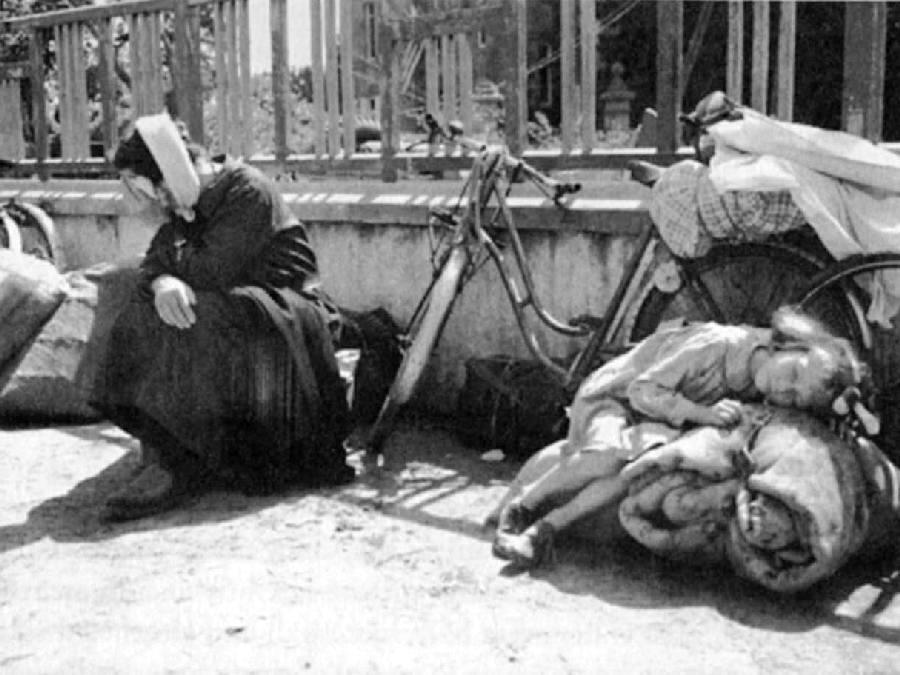
Breakout from Normandy: Mortain Fighting (August 7-13)

Figure 1.--This French mother and child fled the intense fighting around Mortain They reached safety in Saint-Pois, just to the north of Mortaine and safely in American hands. he photograph was taken August 10, 1944 while fighing in Mortain was still raging. Source: U,.S. National Archives.
|
|
Generaloberst Hausser, now in command of the 7th Army, struck (August 7). The German attack plan had been hastily conceived on Hitler's orders. The units involved were in no condition to attack. Many had been battered by Operation Cobra. Others were not well placed to attack west toward Mortain. These units thus had to be committed peacemeal. And there was no Luftwaffe aircover. These Germans thus attacked under what might be called chaotic conditions with inadequate forces. The Germans spearheaded by armor advanced west. The fighting centered on Mortain, but took place in an extensive around it. The Panzer Divisions all had different assigned attack routes. The 2nd SS Panzer Division Das Reich with the attached elements of the 17th SS Panzergrenadier Division Gotz von Berlichingen went straight through Mortain itself. The 1st SS Panzer Division Leibstandarte was not complete and was attached to the 2nd Panzer Division took a different route. Within hours were stopped far short of the coast. They immediately engaged units of the 30th Infantry Division during the Mortain Offensive. Earlier in the War, German armor would have smashed through an infantry division. The Americans had, however, had attached armor and anti-tant units. In addition, infantry units also had portable anti-tank weapons, in this case the bazooka. The bazooka was not as effective as German anti-tank weapons, but it was still extreemly helpful to infantry units facing German armor. While unlikely o pierce a Panther's front armor, it might do damage at the back or knock a track off which in battlefield conditions was nearly as good as destroying the tank. The fight put up by the 30th Infntry was impressive. They faced massively superior German firces, but did not break. Some military historians rank it among the the most impressive performance of U.S. infantry during the fighting in Europe. The 30th Infantry Division managed to delay and slow the German attack. The Division's 120th Infantry Regiment stand on Hills 314 and 285 were key to the American success. This bought time for the major American forces to set in motion a sweeping envelopment. Other U.S. forces then arrived and supported the hard pressed 30th division. Tactical Air Support also played a role in stopping the German advances, although there is some disagreement as to its importance. One author points out that of 17 destroyed Panther tanks found in the Leibstandarte area of the battle, only 4 were found to be destroyed by air attacks while 6 were destroyed by ground fighting. The other 7 were abandoned by the crews when the orders to withdraw came. Ultimately the Germans simply did not have adequate reserves to exploit a break in the American lines
CIH - WWII

Navigate the CIH World War II Section :
[Return to Main Motrain counter offensive page]
[Return to Main Normandy breakout page]
[Return to Main D-Day invasion page]
[Return to Main liberation of Paris page]
[Return to Main liberation of France page]
[Return to Main Vichy page]
[Return to World War II: France]
[About Us]
[Biographies]
[Campaigns]
[Children]
[Countries]
[Deciding factors]
[Diplomacy]
[Geo-political crisis]
[Economics]
[Home front]
[Intelligence]
[POWs]
[Resistance]
[Race]
[Refugees]
[Technology]
[Totalitarian powers]
[Bibliographies]
[Contributions]
[FAQs]
[Images]
[Links]
[Registration]
[Tools]
[Return to Main World War II page]
[Return to Main war essay page]
[Return to CIH Home page]
Created: 5:48 PM 6/21/2013
Last updated: 5:59 AM 4/1/2015



